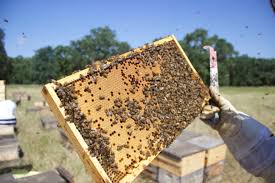Beekeeping Year 2: What to Expect After Winter.

You made the awesome decision of getting started in beekeeping last year and your bees made it through Spring, Summer, and Fall. Soon, we’ll be coming out of winter. What should you expect? What should you do? This is really a matter of opinion. There are many different things you can do. We’ll give you some suggestions based upon what we do.
Opening your beehive the first time after winter
There is a nice 60 degree day so you decide to go open your hive and see what’s going on in there. When you open it up, you find disaster has struck and all your bees are dead. There is a large pile of dead bees on the bottom board, or you find a cluster of bees across several frames with their heads in cells butts sticking out lifeless. Don’t worry! You can get more bees here! So what happened. Of course we want to try to understand why our bees didn’t make it. If they are in a pile on the bottom, they probably were overcome by mites or some ailment. Sometimes you’ll find a mouse nest in your hive. They can get in when it gets really cold and cause a lot of damage.
You might find your bees in little clusters on several frames with their heads in cells. This usually means they ran out of food and starved to death. You might say but there was a lot of honey right next to them. Why didn’t they eat it? Sometimes, during a cold spell the bees will not move enough to get to the food even though it’s close by. Take a look at your cluster size. Is it only baseball size or less? Only on 2 or 3 frames? The cluster was probably too small to stay warm. There could be many other causes as well but these are pretty common ones that will help you diagnose and understand.
So you opened your hive and it survived winter. Congratulations on a successful first year! What do you do now and what should you expect? You’ll want to look at how many frames of bees you have in your hive. If the weather has been relatively warm they could be building up already. Many times they will be mostly in the top box. Some people like to reverse the boxes. Move the top deep down and the bottom deep up. If you had a super on for whatever reason, remove it.
As you are going through your beehive, take note of how much honey is in there and do you see any pollen? How many frames are the bees covering and how much brood is there. Queens in their second year tend to lay really well and build up very fast in the spring. We always feed our bees early in the spring, a 1 to 1 mix because there usually isn’t a good nectar source yet and it helps build up the beehive. We also feed them pollen in the form of a pollen patty.
Splitting your beehive
You’ve opened up your beehive and decide it’s pretty full and you want to make some splits. What is the best way to do this? The answer to this question really depends on what your beehive has available and what you are trying to accomplish. Do you want to go from 1 beehive to 2 beehives or maybe 3 or 4?
We recommend having mated queens on hand the day you are ready to do your splits. You already know what is needed for each beehive because you are now a year experienced so make sure you have the needed equipment based on the number of splits you plan to make.
You’ll want at least 2 to 3 good brood frames for each split. Go through your original beehive and find the best brood frames, the ones that are covered front and back with good sealed brood or mostly sealed brood. Pull 2 to 3 of those frames and place them in the center of your new box. Fill the remainder of the box with new frames or already drawn frames if you have them available. Add your caged queen in between the frames with the most bees and brood on them and make sure you are feeding these new hives as well. Close it up and you’ve now made a successful split off of your original beehive that should grow nicely for you.
Make sure you leave some resources in your original hive as well. It’s a good idea to split it so they are not growing too much too fast and constantly trying to swarm but you don’t want to leave them without bees, brood and food so they can not survive either. With already drawn out frames, food and pollen they should grow very fast.
We hope this helps you understand and get some ideas on what is to come after your first winter. If you are looking to grow and add more bees or beehives to your operation, let us supply you! Keep an eye out for more great tips and tricks from Petric’s Bees and Honey. When you are looking for high quality bees, look no further than Petric’s Bees! petricbees.com/sale order your bees, beehives, 4 frame nucs, 5 frame nucs, and kits today!
